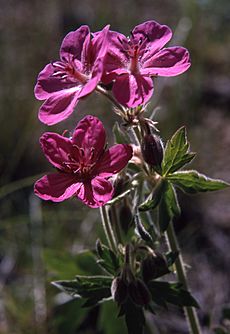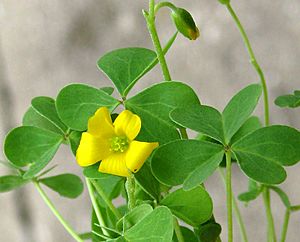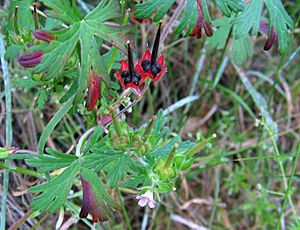List of Geraniales of Montana facts for kids
The Geraniales are an interesting group of plants, like a big family with many different members! In Montana, you can find at least 16 types of plants that belong to this order. Some of these plants are native, meaning they've always grown there. Others are "exotics," which means they were brought to Montana from other places. Some are even considered "Species of Concern," meaning they need special attention to make sure they continue to thrive.
Contents
Geranium Family: The Crane's-Bills

The Geranium family, also known as Geraniaceae, includes many beautiful flowering plants. You might know some of them as "crane's-bills." This funny name comes from the shape of their seed pods, which look a bit like a crane's long beak!
These plants often have pretty flowers with five petals. Their leaves can be deeply lobed, almost like a hand with fingers. Many geraniums grow in meadows, forests, and along roadsides. They can be found all over the world, from cool mountains to warmer areas.
In Montana, you can find several types of geraniums:
- Erodium cicutarium, known as stork's bill
- Geranium bicknellii, Bicknell's geranium
- Geranium carolinianum, Carolina crane's-bill
- Geranium molle, dove's-foot crane's-bill
- Geranium pusillum, small-flower crane's-bill
- Geranium richardsonii, Richardson's geranium
- Geranium robertianum, Robert geranium
- Geranium viscosissimum, sticky geranium
- Geranium viscosissimum var. incisum, sticky purple geranium
- Geranium viscosissimum var. viscosissimum, sticky purple geranium
Life Cycle of a Geranium
Geraniums grow from seeds. Once a seed sprouts, the plant grows leaves and then flowers. After the flowers are pollinated, they produce those special "crane's-bill" seed pods. When the seeds are ready, the pods can split open, sometimes flinging the seeds away from the parent plant. This helps the plant spread to new places.
Some geraniums are annuals, meaning they live for only one growing season. Others are perennials, which means they can live for many years, coming back each spring.
Impatiens Family: The Touch-Me-Nots
The Impatiens family, or Balsaminaceae, is famous for its "touch-me-not" plants. This name is super cool because of how their seed pods work! When the seeds are ripe, if you gently touch the pod, it will suddenly burst open and curl up, shooting the seeds out. It's like a tiny plant explosion!
These plants often have bright, colorful flowers, usually yellow, orange, or pink. They like to grow in moist, shady places, like along streams or in damp forests. Their stems are often juicy and a bit see-through.
In Montana, you might find these Impatiens species:
- Impatiens aurella, pale-yellow jewel-weed
- Impatiens ecalcarata, spurless touch-me-not
Reproduction of Impatiens
Impatiens plants produce many seeds. The "exploding" seed pods are a clever way for the plant to spread its seeds far and wide. This helps new Impatiens plants grow in different spots, making sure the species continues to thrive.
Woodsorrel Family: The Sour Clovers

The Woodsorrel family, known as Oxalidaceae, includes plants that look a lot like clover. Their leaves are often made up of three heart-shaped leaflets. If you've ever tasted them (and it's safe to do so in small amounts), you'd know why they're called "woodsorrel"—they have a distinct sour taste! This sourness comes from a natural chemical called oxalic acid.
Woodsorrels usually have small, delicate flowers with five petals, often yellow, pink, or white. They can grow in many different places, from gardens and lawns to woodlands.
Here are some woodsorrel species found in Montana:
- Oxalis corniculata, creeping woodsorrel
- Oxalis dillenii, Dillen's woodsorrel
- Oxalis stricta, common yellow wood-sorrel
Interesting Facts About Woodsorrel
Woodsorrel leaves can sometimes fold up at night or when it's very hot, and then open again in the morning. This is a cool way for the plant to protect itself and save water. Some people even use woodsorrel leaves in salads or as a garnish, but only in small amounts because of their sour taste.


